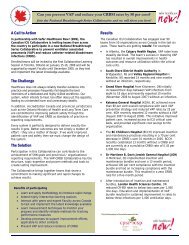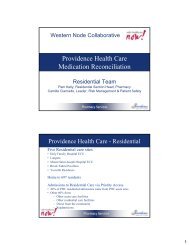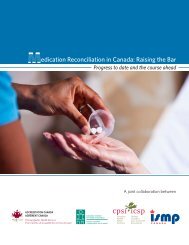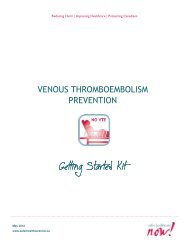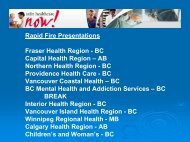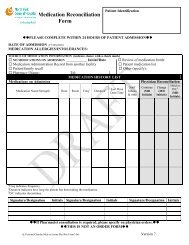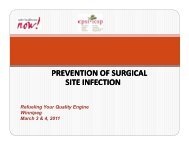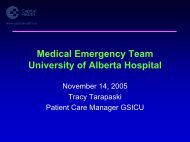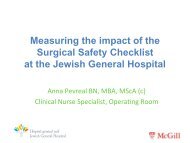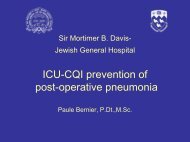VAP Getting Started Kit - Safer Healthcare Now!
VAP Getting Started Kit - Safer Healthcare Now!
VAP Getting Started Kit - Safer Healthcare Now!
You also want an ePaper? Increase the reach of your titles
YUMPU automatically turns print PDFs into web optimized ePapers that Google loves.
<strong>Safer</strong> <strong>Healthcare</strong> <strong>Now</strong>! Prevent Ventilator Associated Pneumonia <strong>Getting</strong> <strong>Started</strong> <strong>Kit</strong><br />
Frequently Asked Questions: <strong>VAP</strong><br />
How do I Diagnose <strong>VAP</strong>?<br />
There is currently much controversy on the accuracy and relevance of current criteria for<br />
diagnosing <strong>VAP</strong>. The major difficulty in establishing universally accepted diagnostic criteria for<br />
<strong>VAP</strong> is that there is no reference standard for <strong>VAP</strong>. In addition, as none of the available<br />
diagnostic tests when performed alone provide an accurate diagnosis of <strong>VAP</strong>, a diagnostic<br />
strategy incorporating a combination of several clinical criteria is required, which then describes<br />
a clinical syndrome called “<strong>VAP</strong>”. Unfortunately, this strategy is burdensome and may lead to<br />
variability in ascertaining <strong>VAP</strong>. 171 The considerable inter-observer subjectivity, inter-institutional<br />
heterogeneity in surveillance/assessment and patient case mix may lead to gaming of the<br />
surveillance process if benchmarking and public reporting add undue pressures to hospital<br />
reputation and compensation instead of being used for internal quality improvement.<br />
In order to address these issues the Center for Disease Control and Prevention Division of<br />
<strong>Healthcare</strong> Quality Promotion is currently piloting various diagnostic strategies in order to<br />
achieve a revised definition for <strong>VAP</strong> that will be objective, streamlined, reliable and potentially<br />
automatable. This will not be a clinical definition but one that will be clinically credible and will<br />
hopefully predict patient outcomes. The reader will be kept abreast of these events through<br />
available CPSI/SHN communication resources (e.g. <strong>VAP</strong> Community of Practice, Canadian ICU<br />
Collaborative Listserv discussion group).<br />
Can I implement most of the <strong>VAP</strong> bundle, but exclude some items?<br />
While this is possible, it is not recommended. In fact, the goal of bundling therapies together<br />
aims to create a linkage between practices that makes the overall process more effective.<br />
Certainly, in terms of monitoring compliance with the <strong>VAP</strong> bundle, “picking and choosing” items<br />
would be unwise however we recognize that Teams starting their journey may implement<br />
components of the bundle in a staged process. Compliance with specific components of the<br />
bundle can in the early stages assist teams in targeting areas for improvement. Hence reporting<br />
compliance with components of the bundle for Teams beginning their process improvement is<br />
acceptable remembering that the ultimate goal however is to implement all elements as early as<br />
possible.<br />
How can you compare <strong>VAP</strong> rates between institutions?<br />
The practice of comparing rates of disease entities or patterns of therapy across institutions is<br />
commonly known as “benchmarking.” Benchmarking may not be a valid method to compare<br />
performance between facilities because of differences in patient population, resource<br />
availability, or severity of illness. Fortunately, none of the work required to improve the care of<br />
ventilated patients requires a comparison of rates between institutions. As long as you establish<br />
methods in your institution to determine the patterns and methods of your regular data<br />
collection, your results will be consistent over time with respect to your own performance and<br />
your own improvement, which is our primary interest. Presumably, any improvements you make<br />
would be reflected in any benchmarking work that you do for other organizations.<br />
June 2012 42



